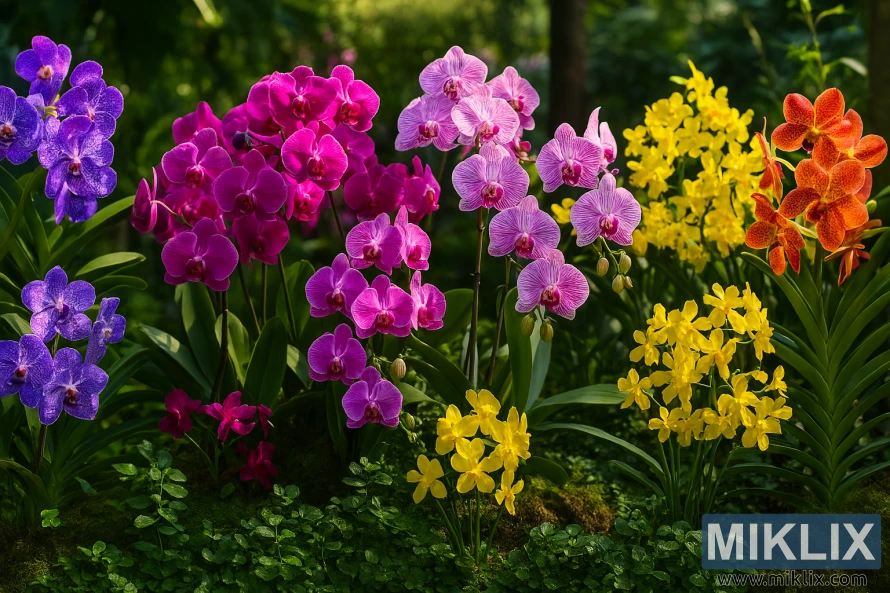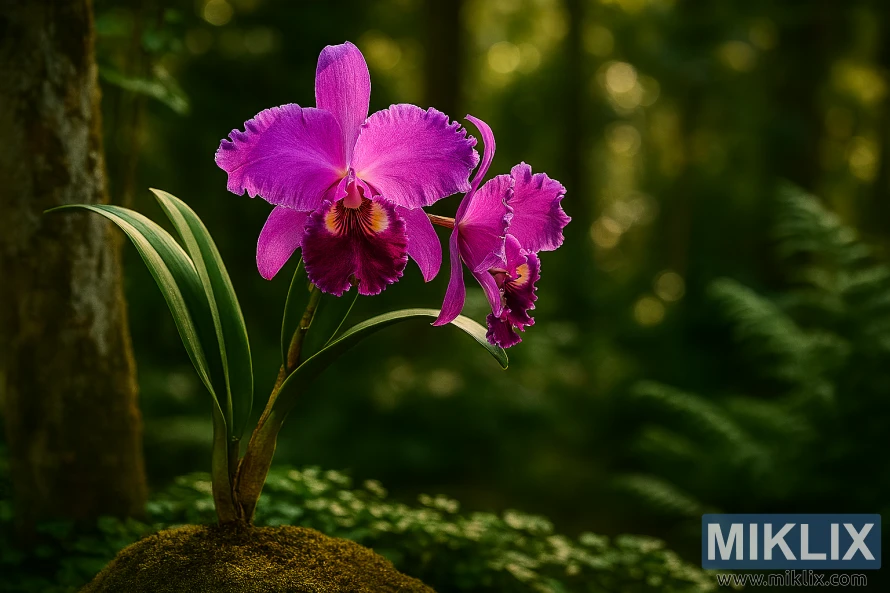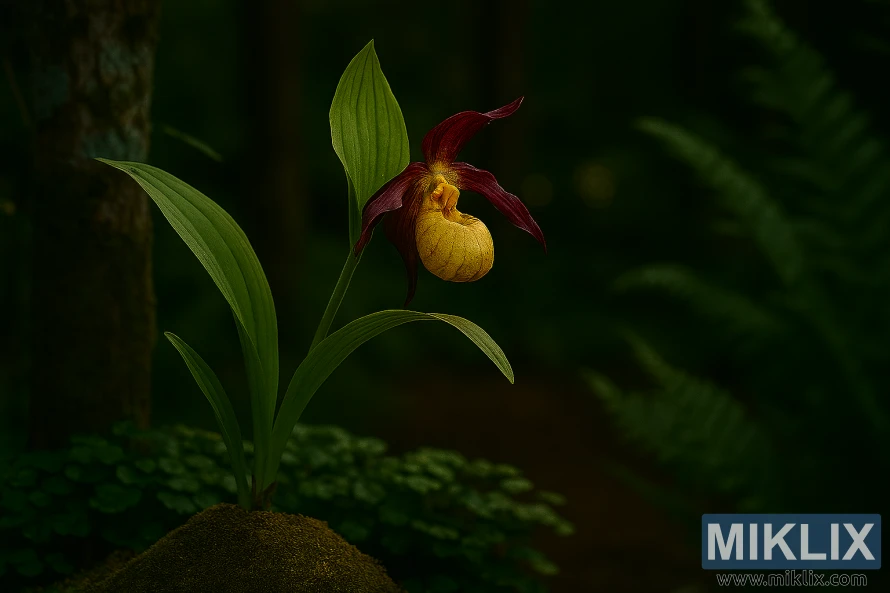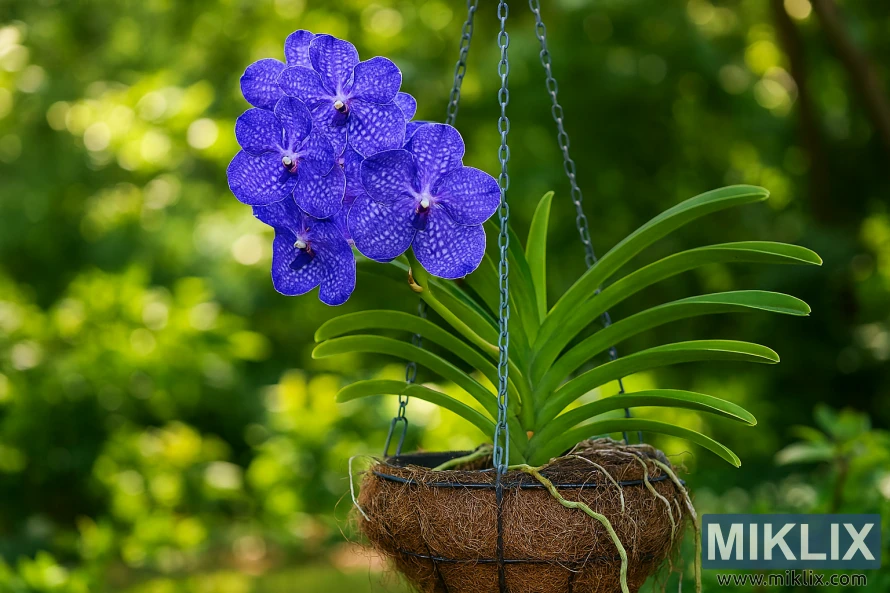A Guide to the Most Beautiful Varieties of Orchids to Grow in Your Garden
Published: November 1, 2025 at 9:07:11 AM UTC
Orchids represent the pinnacle of floral elegance, with their exotic blooms and remarkable diversity making them treasured additions to any garden. While many believe orchids are strictly indoor plants requiring specialized care, several stunning varieties can thrive outdoors in the right conditions.

This comprehensive guide explores the most beautiful orchid varieties suitable for garden cultivation, providing you with the knowledge and confidence to transform your outdoor space into a breathtaking orchid paradise.
Understanding Orchids for Garden Cultivation
Before diving into specific varieties, it's important to understand what makes orchids suitable for garden growing. Unlike their delicate indoor cousins, garden orchids tend to be more resilient, adaptable to temperature fluctuations, and capable of withstanding outdoor conditions. The key to success lies in selecting varieties that match your climate zone and providing the right growing environment.
The beauty of garden orchids lies not just in their exotic flowers, but in their ability to create a sense of tropical luxury in ordinary garden spaces.
Garden orchids can be terrestrial (growing in soil), lithophytic (growing on rocks), or epiphytic (growing on trees). Each type requires slightly different growing conditions, but all can create spectacular displays when properly situated in your garden landscape.
Phalaenopsis (Moth Orchid)

The Garden-Friendly Moth Orchid
While typically grown indoors, certain Phalaenopsis varieties can thrive in protected garden settings in mild climates. These beautiful orchid varieties feature elegant, moth-like blooms that can last for months, making them one of the most rewarding garden orchids.
Growing Conditions
- Light: Bright, filtered light with protection from direct midday sun
- Temperature: Prefers 65-85°F (18-29°C), can tolerate brief periods down to 55°F (13°C)
- Humidity: 50-70%
- Blooming Season: Primarily winter to spring, though some varieties bloom multiple times per year
For garden cultivation, place moth orchids in hanging baskets under trees or in sheltered patio areas where they receive morning light but afternoon shade. Their long-lasting blooms in white, pink, purple, and yellow add a tropical touch to any garden space.
Cymbidium Orchids (Boat Orchids)

The Garden Orchid Champion
Cymbidium orchids are among the most popular and successful garden orchids, known for their hardiness and spectacular flower displays. These beautiful orchid varieties produce tall spikes with numerous waxy flowers that can last for weeks or even months.
Growing Conditions
- Light: Bright light with morning sun and afternoon shade
- Temperature: Can tolerate temperatures from 35-90°F (2-32°C), making them ideal for temperate gardens
- Humidity: Adaptable to various humidity levels
- Blooming Season: Primarily winter to spring
Cymbidiums thrive in garden beds with excellent drainage or in containers placed around the garden. Their strappy foliage provides year-round interest, while their spectacular blooming season transforms winter gardens with colors ranging from white and yellow to pink, red, and deep burgundy.
Dendrobium Orchids

Versatile Garden Beauties
Dendrobium orchids offer incredible diversity, with many varieties well-suited to garden cultivation. These beautiful orchid varieties feature clusters of flowers along cane-like stems, creating dramatic vertical elements in the garden landscape.
Growing Conditions
- Light: Bright filtered light, with some varieties tolerating more direct sun
- Temperature: Varies by type, with some tolerating temperatures as low as 40°F (4°C)
- Humidity: Moderate to high
- Blooming Season: Varies by variety, with many blooming in spring and summer
Garden-friendly Dendrobiums include the Australian Dendrobiums (Dendrobium kingianum) and Dendrobium nobile hybrids, which can be mounted on trees or grown in containers around the garden. Their prolific blooming and relatively easy care make them excellent choices for adding vertical interest to garden spaces.
Cattleya Orchids (Corsage Orchids)

The Classic Garden Showstopper
Cattleya orchids, with their large, fragrant flowers and ruffled petals, bring unmatched drama to garden settings. These beautiful orchid varieties are the classic corsage orchids, known for their bold colors and intoxicating fragrances.
Growing Conditions
- Light: Bright light with some direct morning sun
- Temperature: Prefers 55-85°F (13-29°C), with some varieties tolerating brief periods down to 50°F (10°C)
- Humidity: Moderate to high
- Blooming Season: Varies by variety, with blooms typically lasting 2-3 weeks
In garden settings, Cattleyas perform best in hanging baskets or mounted on trees in protected areas. Their spectacular blooms in shades of purple, pink, yellow, and white create focal points throughout the garden, while their fragrance adds another sensory dimension to the garden experience.
Oncidium Orchids (Dancing Lady Orchids)

Delicate Garden Dancers
Oncidium orchids bring movement and energy to garden spaces with their sprays of small, dancing-like flowers. These beautiful orchid varieties produce numerous blooms on branching stems, creating a cloud-like effect that adds lightness to garden compositions.
Growing Conditions
- Light: Bright filtered light
- Temperature: Most prefer 55-85°F (13-29°C)
- Humidity: Moderate
- Blooming Season: Typically spring or fall, depending on variety
In garden settings, Oncidiums work beautifully in hanging baskets or mounted on trees where their cascading flower sprays can be fully appreciated. Their most common colors include yellow, brown, and red, often with intricate patterns that add visual interest to garden spaces.
Paphiopedilum (Lady's Slipper Orchids)

Woodland Garden Gems
Lady's slipper orchids bring unique charm to shaded garden areas with their distinctive pouch-like flowers. These beautiful orchid varieties are terrestrial, growing directly in soil rather than on trees, making them excellent choices for woodland garden settings.
Growing Conditions
- Light: Shade to partial shade
- Temperature: Varies by species, with some tolerating temperatures down to 40°F (4°C)
- Humidity: Moderate to high
- Blooming Season: Typically winter to spring, with blooms lasting 6-8 weeks
In garden settings, Paphiopedilums excel in shaded woodland gardens with rich, well-draining soil. Their unique flowers in shades of green, burgundy, white, and yellow create conversation pieces, while their attractive mottled foliage provides year-round interest even when not in bloom.
Vanda Orchids

Bold Tropical Statements
Vanda orchids bring dramatic tropical flair to garden spaces with their large, colorful flowers and impressive aerial root systems. These beautiful orchid varieties are known for their vibrant colors, including rare blue hues seldom found in other orchids.
Growing Conditions
- Light: Bright light with some direct sun
- Temperature: Prefers warm conditions, typically above 60°F (15°C)
- Humidity: High
- Blooming Season: Can bloom multiple times throughout the year in ideal conditions
In garden settings, Vandas are typically grown in hanging baskets or mounted on trees where their aerial roots can hang freely. Their spectacular flowers in blues, purples, pinks, and yellows create bold focal points in tropical garden designs.
Essential Care Tips for Garden Orchids
Soil and Potting Requirements
Garden orchids require excellent drainage to prevent root rot. For terrestrial varieties like Cymbidiums and some Paphiopedilums, use a mix of bark, perlite, and organic matter. For epiphytic varieties like Cattleyas and Vandas, use specialized orchid mixes or mount them directly on trees or structures.
Pro Tip: When planting orchids directly in garden beds, create raised areas with excellent drainage to prevent water from pooling around roots.
Watering and Fertilization
Most garden orchids prefer to dry slightly between waterings. Water thoroughly when the growing medium feels dry to the touch, typically every 5-7 days depending on climate and season. During active growth, fertilize with a balanced orchid fertilizer at quarter strength every other watering.

Pest and Disease Management
Garden orchids can be susceptible to pests like aphids, scale, and snails. Regular inspection and prompt treatment with horticultural oils or insecticidal soaps can prevent infestations. Good air circulation is crucial for preventing fungal and bacterial issues.
Winter Protection
In temperate climates, provide winter protection for garden orchids by moving container specimens to sheltered locations or covering garden-planted varieties with frost cloth when temperatures drop below their tolerance range. Reduce watering during winter months to prevent cold damage to wet roots.
Designing with Orchids in Your Garden

Creating Orchid Focal Points
Use the dramatic beauty of garden orchids to create focal points throughout your landscape. Place Cymbidiums in decorative containers along garden paths, mount Cattleyas and Dendrobiums on garden trees, or create a dedicated orchid garden section with a variety of species for year-round interest.
Companion Planting
Pair garden orchids with complementary plants that share similar growing requirements. Ferns, bromeliads, and heucheras make excellent companions for shade-loving orchids, while bird of paradise and hibiscus complement sun-tolerant varieties in tropical garden schemes.
Vertical Orchid Gardens
Maximize garden space by growing epiphytic orchids vertically. Create living walls with mounted orchids, use decorative branches as natural supports, or install specialized vertical garden systems to showcase your beautiful orchid varieties in even the smallest garden spaces.
Seasonal Displays
Plan your orchid garden to provide year-round interest by selecting varieties with different blooming seasons. Combine winter-blooming Cymbidiums, spring-flowering Dendrobiums, and summer-blooming Vandas to ensure your garden always features spectacular orchid displays.
Troubleshooting Common Garden Orchid Issues
Why aren't my garden orchids blooming?
Insufficient light is the most common reason for lack of blooming. Most garden orchids need bright, filtered light to produce flowers. Other factors include improper temperature fluctuations (many orchids need a temperature drop to initiate blooming), inadequate fertilization, or overcrowding that prevents proper development.
Why are my orchid leaves turning yellow?
Yellowing leaves can indicate several issues: natural aging (lower leaves), overwatering leading to root rot, sunburn from too much direct light, or nutrient deficiencies. Check the roots—healthy orchid roots should be firm and white or green, not brown and mushy.
How do I protect my garden orchids from extreme weather?
For heat waves, provide additional shade and increase watering frequency. For cold snaps, move container orchids to protected areas or cover garden-planted specimens with frost cloth. Consider creating microclimates in your garden using walls, fences, or larger plants to buffer orchids from extreme conditions.
Embracing the Beauty of Garden Orchids
Growing beautiful orchid varieties in your garden opens up a world of exotic beauty that few other plants can match. With the right selection of garden-friendly orchids and proper growing conditions, you can create spectacular displays that transform your outdoor space into a floral paradise. From the dramatic blooms of Cattleyas to the delicate dancing flowers of Oncidiums, garden orchids offer endless possibilities for creative expression.
Don't be intimidated by orchids' reputation for difficulty—many varieties are surprisingly resilient and adaptable to garden conditions. Start with hardy varieties like Cymbidiums or Australian Dendrobiums, and as your confidence grows, expand your collection to include more specialized beauties. The rewards of growing these extraordinary plants in your garden are well worth the effort, providing years of spectacular blooms and the satisfaction of nurturing some of nature's most remarkable floral creations.
Further Reading
If you enjoyed this post, you may also like these suggestions:
- A Guide to the Most Beautiful Clematis Varieties to Grow in Your Garden
- A Guide to the Most Beautiful Dahlia Varieties to Grow in Your Garden
- A Guide to the Most Beautiful Rose Varieties for Gardens
